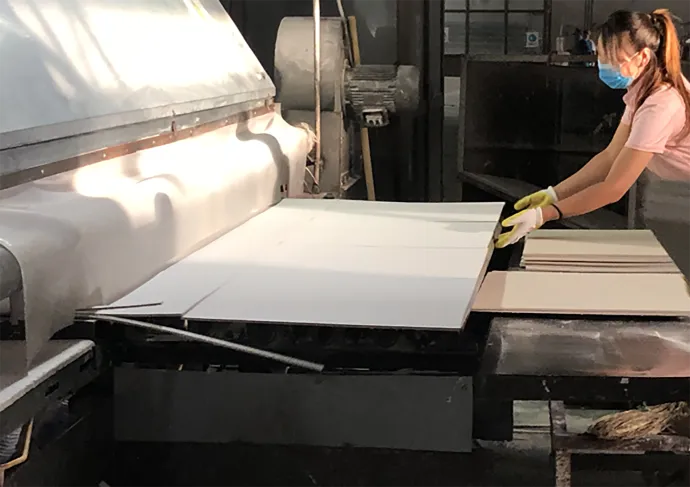9 月 . 28, 2024 22:15 Back to list
High-Performance Rigid Mineral Wool Insulation Board for Enhanced Energy Efficiency and Sustainability
The Versatility and Benefits of Rigid Mineral Wool Board
In recent years, the construction industry has seen significant advancements in insulation materials aimed at improving energy efficiency and sustainability. Among these materials, rigid mineral wool board stands out for its exceptional properties and versatility. This article delves into the features, advantages, and applications of rigid mineral wool board, showcasing why it is a preferred choice for modern construction projects.
What is Rigid Mineral Wool Board?
Rigid mineral wool board, also known as rock wool or stone wool, is made from natural basalt rock and recycled materials. The production process involves melting the rock and spinning it into fibers. These fibers are then formed into rigid, dense boards that provide effective thermal and acoustic insulation. The material is non-combustible and offers excellent fire resistance, making it an ideal choice for various applications, particularly in buildings where safety is a priority.
Thermal Performance
One of the standout features of rigid mineral wool board is its superior thermal insulation properties. The board’s fibrous structure creates numerous air pockets, which significantly reduce heat transfer. This results in lower energy consumption for heating and cooling, leading to increased energy efficiency in buildings. With a thermal conductivity value typically ranging between 0.035 to 0.045 W/mK, mineral wool boards provide effective insulation that helps maintain comfortable indoor temperatures year-round.
Acoustic Insulation
In addition to thermal performance, rigid mineral wool boards are also known for their excellent sound absorption qualities. The dense fibers help to dampen sound waves, making these boards particularly beneficial in multi-family housing, commercial buildings, and industrial applications where noise reduction is crucial. By incorporating mineral wool boards into walls, ceilings, and floors, architects and builders can create quieter environments that enhance the overall quality of life for occupants.
Fire Resistance
rigid mineral wool board

Fire safety is an essential consideration in building design, and rigid mineral wool board excels in this aspect. The non-combustible nature of the material means it can withstand high temperatures without igniting or contributing to the spread of fire. Mineral wool boards have been tested and classified according to international fire regulations, ensuring that they meet strict safety standards. This makes them suitable for use in high-risk areas, such as boiler rooms or around heat-generating equipment.
Environmentally Friendly
Sustainability is a crucial factor in today’s construction practices, and rigid mineral wool board is an environmentally friendly choice. The material is made from natural and recycled components, and its production process produces minimal waste. Additionally, the energy savings achieved through its insulating properties contribute to reduced greenhouse gas emissions over the lifespan of a building. Many manufacturers also prioritize sustainable production methods, further enhancing the environmental credentials of mineral wool insulation.
Applications in Construction
Rigid mineral wool boards are versatile and can be used in a variety of applications. They are commonly employed in thermal insulation for walls, roofs, and floors in both residential and commercial structures. Their soundproofing qualities make them ideal for use in theaters, music studios, and office buildings, where noise control is paramount. Furthermore, these boards can be used in industrial settings, including factories and power plants, to enhance safety and improve working conditions.
Installation and Maintenance
Installing rigid mineral wool boards is relatively straightforward, with various methods available depending on the specific application. The boards can be cut to size and fitted into wall cavities, ceilings, or as part of an exterior insulation finishing system (EIFS). Maintenance is minimal since the boards are resistant to mold, rot, and pests, contributing to their longevity and reliability as an insulation solution.
Conclusion
Rigid mineral wool board is a high-performance insulation material that offers numerous benefits, including excellent thermal and acoustic insulation, fire resistance, and sustainability. Its versatility makes it suitable for a wide range of applications, enhancing the energy efficiency and safety of buildings. As the construction industry continues to prioritize sustainable practices, rigid mineral wool board is poised to remain a top choice for architects, builders, and homeowners alike. Investing in such innovative materials not only improves the quality of our living and working environments but also aligns with global efforts toward environmentally responsible construction.
-
Revolutionizing Interior Design with Ceilings t grid Suspended SystemNewsOct.29,2024
-
Revolutionizing Ceiling Design with ceiling access panel with Gypsum Tile WaterproofNewsOct.29,2024
-
Revolutionizing Interior Design with PVC Gypsum Ceiling: A Comprehensive GuideNewsOct.29,2024
-
Elevating Interior Design with High quality Mineral Fiber Ceiling TilesNewsOct.29,2024
-
Revolutionizing Interior Design with PVC Gypsum Ceiling: A Comprehensive GuideNewsOct.29,2024
-
Elevating Interior Design with High-Quality Mineral Fiber Ceiling Tiles: A Comprehensive GuideNewsOct.29,2024







